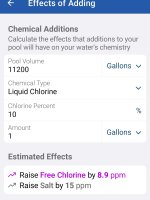So stabilizer (CYA) sits in the chlorinator and eats away at that device, the check valve, and the heater? Are there some sources for this? Additionally, at what level does this occur?(Cyanuric) Acid sits in the chlorinator and eats the valve when it's off, eventually oozing out when the pump is off. Then it eats whatever else is there. Check valves are installed between the heater and tab feeder specifically for this purpose, but the acid eats the check valve too, then the heater.
Its not a question of if, but when. It doesn't take but a year or two.
They all install a check valve, but as anything sacrificial, it only lasts so long. I circled yours.
View attachment 634104
I understand but it was just yesterday folks on here were telling me it's fine to use tablets on occasion / sparingly with the knowledge of the FC/CYA relationship. Now that seems to not be the case. Is this something I should discuss with our builder?We get it and generally do our best to use kid gloves to break the news. We have met 'you' lirerally hundreds of thousands of times. We will continue to meet you over and over again, starting from scratch each time with each newb.
There's a reason why so many keep seeking us out. Keep an open mind and we'll keep trying to teach you kindly.



